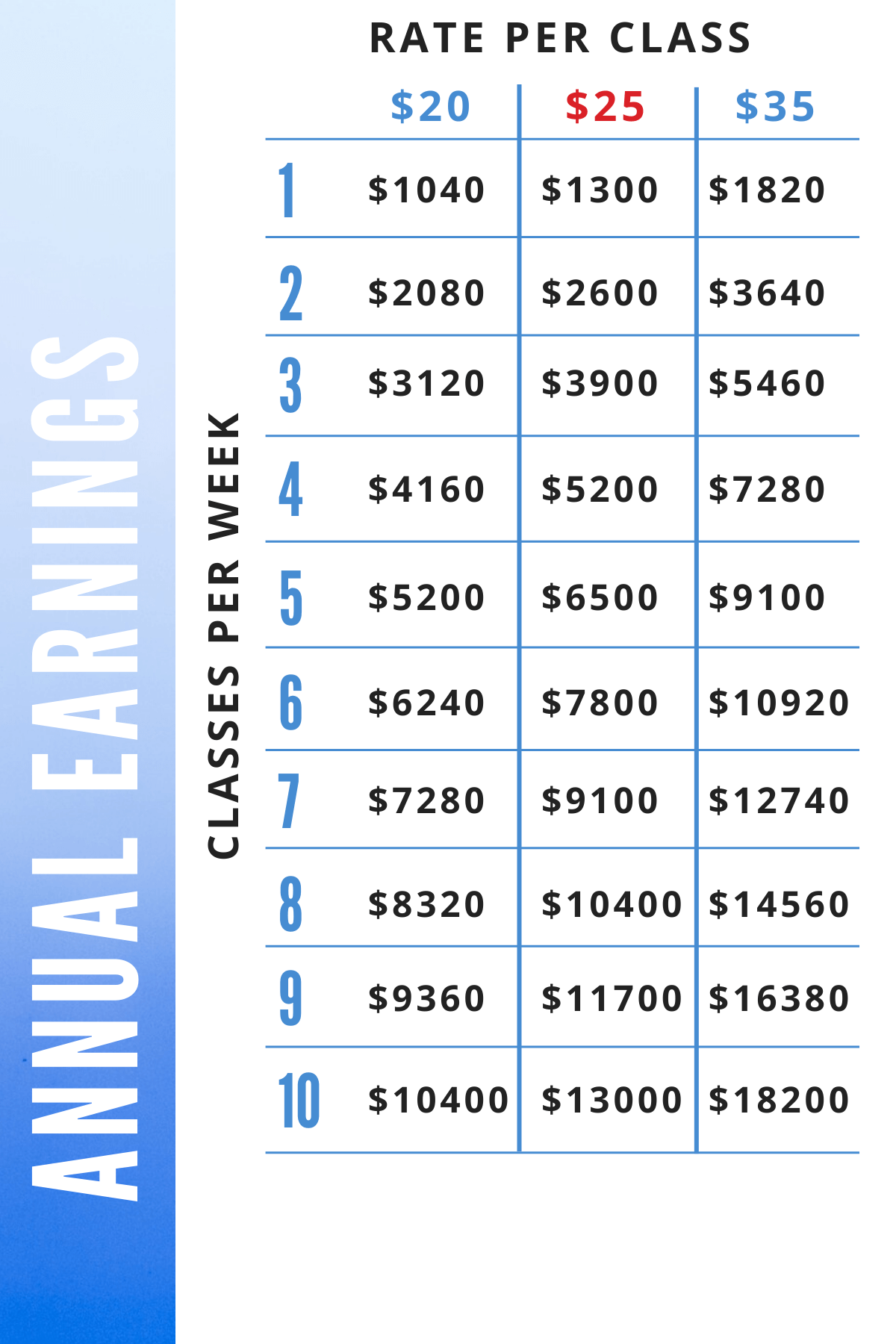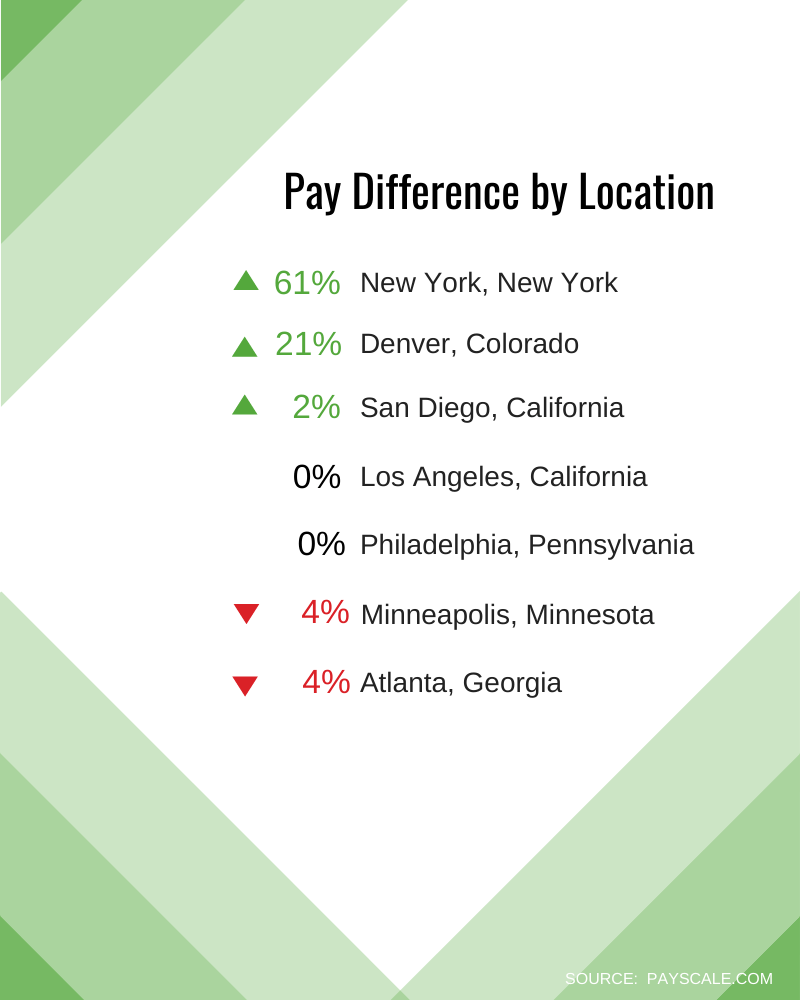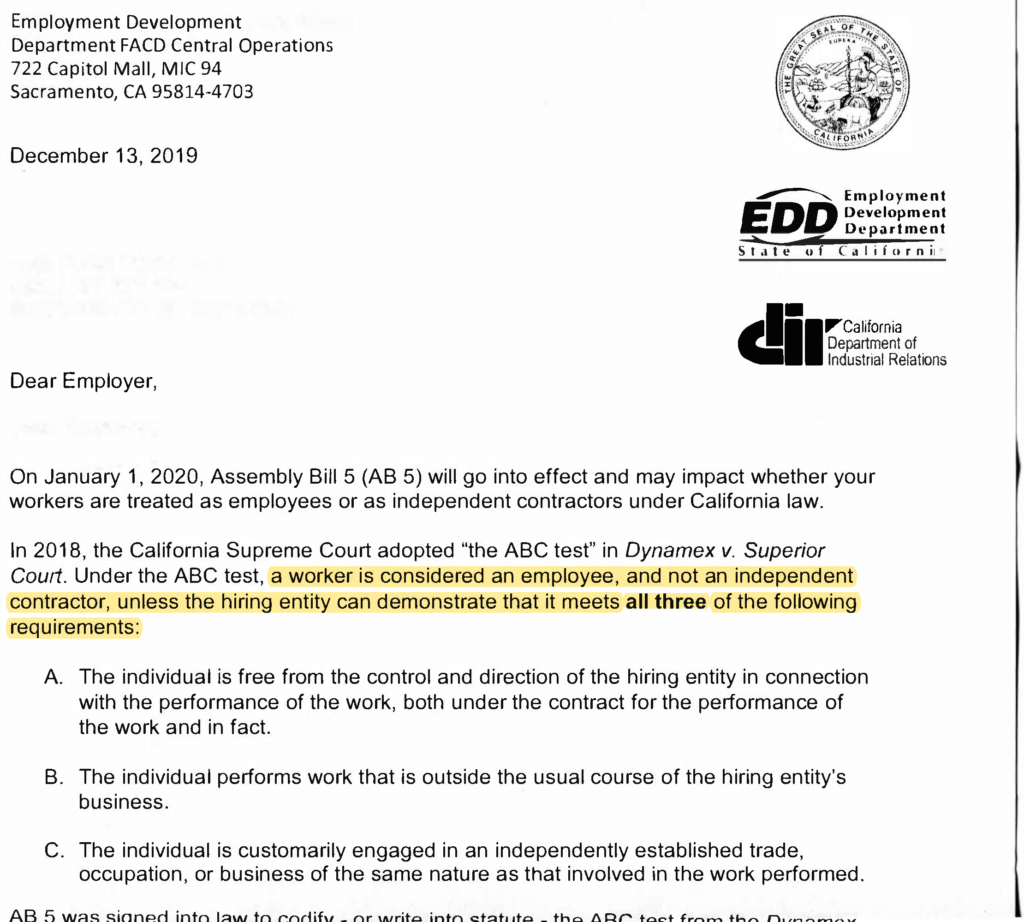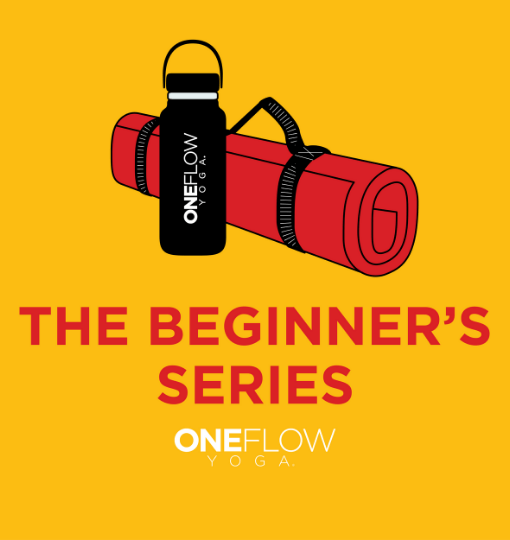How much do yoga teachers earn? How much do yoga instructors make? If you are asking the question, then you are probably trying to decide if becoming a yoga teacher is worth it financially. Will you be able to pay your bills and eat while you are sharing bliss with the world? Consider this to be a comprehensive guide to all things pay related; a deep dive into yoga teacher pay. It’s appropriate for yoga teachers and yoga studio owners alike.
This pay guide is different from others because of the real-world experience behind it. We’ll go beyond the basic pay models to give you an overview of the economics and other factors affecting pay. We’ll share actual data and show how the market you are in will potentially affect your income. Finally, we’ll give you insight into what a yoga studio considers when it comes to pay.
Below is the outline we’ll cover. While we recommend reading the entire guide, feel free to click on any topic to be taken to that section.
- Economics 101
- The Creative Artist Model
- The Yoga Studio Model
- The Online Model
- The Union Model
- How Much Do Yoga Teachers Earn DATA
- The Size of Market Model
- Standard Pay Models
- Why You Should Trust Us
Economics 101
Economics, briefly, is about allocating scarce resources. The term scarce is used when there is not enough of a resource to go around, like housing. The opposite term is free and abundant, like air. The ideas of supply and demand say that as the supply of something becomes more scarce, the price for it will increase.

It’s why certain comic books that initially sold for 12¢ in the 1960s are now worth thousands of dollars. Or maybe sneakers are your thing. There are pairs that garner as much as $20,000 on the trading market because they are rare.
This affects you as a yoga teacher in a few ways. The first can be dubbed “free yoga in the park.” If yoga is free, why would you want to pay for it? Free yoga devalues and discounts yoga and, in turn, yoga teachers.
Just think, if Apple gave iPhones away for free, what do you think they would be worth?
It’s admirable people want to share yoga and help others. But offering yoga for free follows the law of unintended consequences; it lowers how much people are willing to pay for it. To become a skilled yoga teacher takes time, effort, and yes money.
Perhaps we can rethink how we give back and provide financial assistance for people who need help? Many other professions, from doctors to dentists, attorneys to accountants do pro bono public, or work “for public good.” It’s a way of giving back and helping out people “with limited means” or supporting “organizations designed primarily to address the needs of persons of limited means.” (Model Rule 6.1 Professional Conduct of the American Bar Association).
Another way to do this would be to create or join special charity events that benefit the same kinds of organizations. These events serve everyone from St. Jude’s Children’s Research Hospital and the March of Dimes to local food banks and homeless shelters.
The other part of scarcity is the numerous yoga teacher training graduates. It may seem like there’s an infinite supply of teachers, which again lowers the price, or pay for all yoga teachers. But teachers aren’t widgets.
Thinking all yoga teachers are the same is similar to thinking all podcasts are great, just because everyone now has one. There’s a huge difference, though, in teaching quality that should be reflected in what yoga teachers earn.
Why Shouldn’t Yoga Be Free?
Economics addresses the question, why shouldn’t yoga be free? The short answer is because there are costs associated with yoga. It’s obvious to see this with yoga studios as they have all of the costs of any other business. However, even free yoga in the park has to contend with the costs for permits, sound systems, if a microphone is used, web hosting fees if a website has been created, etc.
The other part of the answer involves the value of yoga.
The Creative Artist Model
In “How to Become a Yoga Teacher,” I describe how yoga teachers are in the creative arts like chefs, writers, or musicians. This is true in matters of pay and possibility too.
In the creative arts, you have a lot of people making a little bit of money and a few people making a significant amount of money.

Take writers. In 2017, the Median Pay for Full Time Writers was $20,300
If you include Part-Time Writers, the amount goes down to $6080.
“There’s no other job in the world where you get your master’s degree in that field and you’re like, ‘Well, I might make zero or I might make $5 million!’” New York Times
Why the vast disparity in income for writers and other creatives? This will be addressed in an upcoming article about making a sustainable living.
As a yoga teacher, you are in business for yourself, an entrepreneur, and it’s helpful to think like one.
“People who succeed tend to have more of an entrepreneurial spirit,” said Michael Levine, a hairstylist, and chief executive officer of the Vancouver-based Michael Levine Salon Group
Taylor Swift clearly gets that she is an entrepreneur. Arguably one of the most influential creative artists of the last decade, Taylor has become successful because of her hard work—a key theme for creatives who thrive.
Taylor’s former manager, Rick Barker, says that when she met him, she had an initial goal of earning a gold album. His answer was along the lines of, “Then let’s go introduce you to 500,000 people,” as that’s how many records you have to sell for gold.
And she was in, playing anywhere and everywhere and signing autographs for so long they would close the venue, move Taylor outside and hold up a flashlight so she could keep signing. Wow! Her success is no accident, but the result of a lot of repeated effort. That’s very yogic. Tapas is the term we usually use to describe building some heat, like rubbing two sticks together to start a fire.
Fire from friction is an apt metaphor because it can literally take you eleven hours to do it. That’s the second component of success as a creative—time. If you only rubbed the sticks together occasionally, the fire is never going to ignite. You have to keep at it.
But before that fire catches, you need an income, which is where the realization from Rachel Whitener, private chef, comes in. She started out initially as a pastry chef.
Mary Rasenberger, executive director of the Authors Guild, seconds this insight saying, “the people who are able to practice the trade of authoring are people who have other sources of income.”
The Yoga in America survey further backs this up, finding only a third (29%) of yoga teachers rely on teaching yoga as their primary income.
By the way, Rachel now teaches yoga, having graduated from YTT in 2019. Yes, everyone is a yoga teacher now.
In any creative industry, there are going to be dues to pay. Paying your dues in this context means.
Work on your craft [This will make what you do more scarce]
Grow the demand for what you do [This will increase the demand for what you offer]
Both are necessary before your value will go up.
This is why you have the stereotype of the actor who is a server at a restaurant. Of course, nowadays, I meet more actors who drive for Lyft and Uber. #gigeconomy
Believe it or not, the fortunes of Uber and other gig companies affect how much yoga teachers make. Read the section on “What do Yoga Teachers Make” to see why it matters.
Even if you graduated from one of the best schools for what you do, like Julliard is for music, it still takes work.
“Just because you play really well,” he said, “that’s not enough. You need vision, you need persistence, you need passion for what you do, and you need to provide something unique.” Ittai Shapira Julliard Class of 1994
Takeaways
- It takes time and hard work to become successful as a yoga teacher.
- Focus on your craft and growing the demand for what you do.
- The creative arts, like yoga teaching, will not support you initially. Find supplemental work.
The Yoga Studio Model
“I Rob Banks Because That’s Where the Money is” Willie Sutton, Bank Robber
Why talk about how yoga studios make money? Because yoga studios provide the highest number of job opportunities for yoga teachers.
Yoga Studios only make money a few ways:
- Selling Classes
- Selling Memberships
- Selling Workshops and Retreats
- Selling Teacher Training
- Selling Retail
In 2016 only 22% of Yoga Studios reported over $100,000 in income, or about 1 in 5. (Source: Ipsos Public Affairs 2016 Yoga in America Study)
That’s for the entire studio. And the costs are considerable with labor and rent comprising anywhere from 50-75% of total income—that’s before utilities, marketing, software, etc.
Clearly, The Yoga Studio Model is not a get rich ever entity, which is why Willie Sutton wouldn’t rob one. People going into this space aren’t doing it for the money.
The Equation
The equation for a yoga studio is how do you have the best yoga teachers who are well compensated, keep the lights on, all while focusing on what consumers will pay based on the value they receive.
Consider in the late 1920s in the U.S. a single yoga class cost $5, or about a day’s wage. In 2019 that would be $181 for a single class. (Source: The Swami Circuit: Mapping the Terrain of Early American Yoga) At rates like that, yoga studios would be more viable, and making a lucrative living wouldn’t be an issue for a yoga teacher.
Sadly we’re about 10% of that historical rate.
Competition is also withering for yoga studios. Not only are there more brick-and-mortar physical locations, and corporate chains like Corepower, Yoga Works and Equinox, but there’s the rise of online video platforms and YouTube. [See The Online Model Below] Competition also comes in the form of Classpass.
The Classpass a.k.a. Discount Model
Classpass is something called an aggregator. It builds an audience and then directs it to various offerings.
If this formula sounds familiar, it’s because it’s the same model as Groupon and LivingSocial.
Classpass is particularly insidious because they have an online offering to compete directly with studios. Imagine Groupon getting into the spa, tire, cupcake, business when you own an enterprise in those industries.

The Classpass (Groupon) Model is devastating to yoga studios because they work at a discount.
They promise to “fill your classes” but at 50% off your standard rate. Ouch.
Yoga studios who are smart about their pricing look at The Equation [See The Yoga Studio Model above] and price their classes per the value they deliver, taking into account their expenses and a reasonable profit margin.
If you move to the Classpass, a.ka. Discount Model, you have to adjust the variables, and this is where yoga teachers’ salaries come in.
But first, why can’t Classpass just pay the full rate?
The full price model has been tried in other industries—See Movie Pass. But it didn’t work for a simple reason. Without getting a discount, Classpass can’t make money.
Classpass changed its business model a few times and had to, according to a Harvard Business School article. It found in 2017 Classpass, “occupied an uncomfortable position” It needed consumers who liked the platform, but not too much, because if consumers took more than 10 classes a month, Classpass would lose money. And it needed “studios that were popular enough to attract customers, but not too popular,” because if a studio is popular, it doesn’t need Classpass.
If you are a popular yoga studio, you don’t need Classpass.
And now that they compete directly with you for students, you really don’t need Classpass. The only thing worse would be if Classpass stole your car, wrecked it, ate all of the food in your fridge, and dated your best friend—only to break their heart. Then you really, really don’t need Classpass.
As I write this, I just received this email from LoveStory Yoga, a very popular studio in San Francisco, about this realization.
12/13/19
Dear Love Story family,
Over the past year, Classpass has changed its terms and restrictions several times, making it increasingly difficult to remain true to our values and vision – to be a home for the urban yogi who craves a strong physical and spiritual practice, among friends, in a beautiful, warm space. With Classpass’ latest iteration, it is clear that we are no longer aligned, and we have made the decision to remove ourselves from the platform. Dec 25th will be the last day you will be able to take a Love Story class through Classpass.
The Classpass, Groupon pitch, was always, “Fill your classes.” They suggested that if people liked what you offered, they would stay with you. Then is it worth the discount? I’m still a hard No. But, the point is moot because, as a July 2019 article in Inc Magazine states:
“ClassPass allows subscribers to take local classes—with no expectation to join any one studio.”
Clearly, they want their subscribers to stay in the Classpass ecosystem.
Discounting has other issues too.
There are companies like Zenrez that prices your classes dynamically—thus the phrase “dynamic pricing.” It uses Economics 101 by automatically adjusting the price in response to the demand. You can read more about it here.
My biggest issue with dynamic pricing is that you are in an airline model with everyone paying wildly different amounts. The person right next to you may have paid $200 more or less than you for the same seat. I never feel right about that. I think people want the best deal that’s fair, and not to feel like a winner sometimes, and other times like a sucker. And they never know which one they are.
As a yoga studio or any other business, you teach consumers how you price by how you price. If you always have sales, people will always expect a sale. The same is true if you never have a sale. Macy’s has taught people to expect at least three different discounts for any transaction. Apple has taught us to expect to pay full price.
If you offer discounts, especially at the last minute, you are teaching people to wait until the last minute to book—because no one wants to be the sucker.
Ok, rant over. Just give people a great value.
How does all of this affect how yoga teachers are paid? Moving to a Discount Model is a death spiral. We’ve seen this a lot when yoga studios would jump on Groupon as a last-ditch effort for students—right before closing for good.
If a studio is going to use discounting as a strategy, then they have to raise their prices, and they have to reduce expenses. This must be done because there’s no such thing as free yoga, and your costs still have to be covered.
Recall the two most significant expenses for a yoga studio are rent and labor. You could try renegotiating your lease for a lower one, but that is very market dependent. It’s more likely your rate is going to go up. This is why yoga studios start to disappear around the 10-year mark, a normal expiration for long-term leases.
The other big expense is labor. If a yoga studio is committing to a Classpass Model, then it has to look at reducing teacher pay. You can see why this is a downward spiral because if you lower teachers’ compensation, you can expect them to leave. And with a lower pay rate expect to have a harder time attracting new teachers.
Takeaways
- Yoga Studios provide excellent opportunities for yoga teachers
- Owning a yoga studio is a difficult, not well-compensated endeavor
- Competition continues to increase for yoga studios
- Discount yoga is not a sustainable model without lowering costs, including yoga teacher pay.
Yoga with Adriene—The Online Model
More and more, I ask students where they’ve practiced before, and they cite “Yoga with Adriene.” And I admire her hustle. You don’t make over 500 videos without showing up consistently.
Before YouTube, Adriene taught a local class for a little while and says she was always trying to come up with unique ways to encourage students to come to class.
The best I can tell is she’s a 200 Hr teacher, but I don’t see her in the Yoga Alliance database. Not that she needs it.

Why is Adriene successful. A few reasons.
- She’s warm and friendly. That goes a long way.
- She’s also consistent as the 500+ videos speak to.
- She has a very capable business partner, Chris Sharpe, who had another successful YouTube channel, Hilah Cooking, before yoga came along. He reached out to her in 2012, and that’s when things began to happen.
- She is a professional actor. That helps when you’re in front of a camera.
How does Adriene make money? Chris says it’s not an ad model—which is where you get paid by advertisers for how many views your channel gets. It’s more of an online class model with “merch,” and yes, a tour. It’s not your imagination, this is the Rock Star Model. Build an audience by creating, go on tour, and sell t-shirts.
And she did it the right way—building an audience first.
Too many creatives get this backward. Diana Rodriguez is CEO of Criteria Entertainment, a music label specializing in Latin label. She says so many artists tell her they, “…want to release tomorrow,” and “release in all these territories,” and she asks, “Why? So you spent the year recording this album, with 12 amazing tracks, and you want to all send it out tomorrow…who’s waiting for this?”
Who is waiting for you to teach? [What is the demand]
Yoga is the what—the content.
Teaching is the how. It’s the skill; the craft.
When, Where, and Who are the big questions.
In the beginning, it’s anyone who will let you. Comedian Mike Birbiglia jokes about opening for a raffle. Today, he’s reportedly worth over $4 million.
And how much does Yoga with Adriene make? Hmm, that’s a tough one because anything is just a guess. I’ve seen figures from $25,000 a year to over $400,000. My take is she’s probably making at least $30-$50k a month, or around $500,000+ a year. But it’s also taken her almost 8 years to get there.
Can this be replicated? That’s hard to say because of something called first-mover advantage. It means there is an advantage the first person who moves into a market enjoys. Adriene was the first prominent yoga YouTuber, but not the last.
Need further encouragement? Tesla didn’t start as a car company until 2003, almost exactly 100 years after the Ford Motor Company, and today there’s a huge demand for what they do.
Takeaways
- Whether online or in-person you still need to know how to teach
- Warm and Friendly is always a winning combination
- There’s a lot more to know besides yoga
- Oh, and it’s a lot of work. (And time—never forget time.)
The UNION Model
Recently there’s been talk about raising yoga teacher pay by unionizing, especially at Yogaworks in New York.
Since it’s out there, we’ll pause for a moment and address yoga unions.
Are Unions a good idea or a bad idea?

The basic premise of a union is that workers join together and negotiate with management as a single unit. The thinking is that there’s more power if we all bargain together, or collectively, rather than individually—thus the term collective bargaining unit.
Union membership enjoyed a high of 30% of the American workforce at one time, but today it is closer to 10%, a number that includes both public and private unions.
Unions can be a force for positive change in workers’ lives, but it depends on what kind of system you are in. In the United States, we have an enterprise-based negotiation system, which means the union must negotiate company-by-company.
Europe’s model is overwhelmingly sectoral collective bargaining, which allows unions to negotiate with an entire industry. This strengthens the effectiveness of European unions and gives them far greater influence over wage rates than their American counterparts.
What’s the difference? If a union is successful in the United States, it might unionize one Yogaworks. The union would then negotiate on behalf of the workers at that one location to create a contract. In Europe, by contrast, a union would be able to negotiate with all of the yoga studios in Germany at once.
It’s an understatement to say United States businesses are not a fan of unions. There have been cases where locations have been closed by companies, rather than to allow a union to come in.
If you successfully created a union for yoga teachers, there are a couple of things to know.
- You will be covered by a collective bargaining agreement. It specifies what work is to be done, who will do it, and the rate of pay, among other things.
- Pay rates are listed as a pay matrix and tend to favor people who have been with the company the longest.
- Classes that open up are offered to teachers based on their seniority, and the company goes down the list from most senior to least until someone takes the class.
- You will also have a union representative called a shop steward in any meeting with management. There is no direct individual negotiation with management.
- Finally, you pay union dues out of every paycheck. There are costs associated with running a union, and every member contributes a certain percentage to help cover them.
One other pesky thing. If a yoga studio in town has a union, but the other studios do not, it puts that one at a competitive disadvantage.
Takeaways
- Unions can be powerful forces that affect wage rates—in Europe.
How Much Do Yoga Teachers Earn Data
To come up with real data, I gathered figures from Indeed, Glassdoor and Payscale, and then married them with the results from the Yoga in America Survey. The analyses are there to help you make sense of it.
51% of yoga studios serve less than 100 students a week.
Analysis: Most yoga studios are small.
67% of yoga teachers work less than 10 hours a week. A full 37% work less than 5 hours a week.
Analysis: The vast majority of yoga teachers teach yoga part-time.
47% are independent contractors
35% are employees
Analysis: Independent contractors are the preferred way to classify yoga teachers.
70% of yoga teachers are paid a flat fee.
Analysis: Read the Standard Pay Models section below to see how this affects you as a yoga teacher.
Source: Yoga in America Study By Yoga Journal and Yoga Alliance in conjunction with Ipsos Public Affairs
Yoga Teacher Salary Survey

What is the average yoga instructor salary in the United States?
$25.00*
What is the average yoga instructor salary in California?
$36.00
What is the average yoga instructor salary in New York?
$44.00
Where does this information come from?
Indeed.com is an aggregator of jobs posted online. It analyzes job postings to get title (e.g., yoga instructor), pay, and location. Size matters. Indeed has more data points, in this case individual yoga salaries, 1649 and 270 respectively. This gives a more reliable figure for the U.S and California. The New York number is not as reliable, with only 47 data points.
Glassdoor.com features more self-reports from employees, so their sample size is not necessarily representative as it can be skewed by the people choosing to report. Payscale.com uses surveys to compile information. Both can be used as a check of how realistic Indeed’s number is.
U.S. Bureau of Labor Statistics is part of the U.S. Department of Labor charged with measuring labor market activity and has a wealth of information on various occupations. Again, it’s another verification source.
The challenges of relying on online sites.
Online sites annual salaries assume you’ll be working a traditional workweek, 5 days a week, 8 hours a day.
Only that’s not how most yoga teachers work. They work by the class. You need to know the hourly rate to make this more relevant to how yoga is compensated.
To get it, use this quick rule of thumb. Divide any annual salary you come across by 2000.
Here’s the longer calculation if you’re interested.
First, you need to know the actual working days in the year. You find this by taking total weeks, 52, times the number of days, 5, and deducting holidays.
For 2019 and 2020 they are:
2019: 251
2020: 252
2020 has one more day because of leap years.
Multiply each by 8, and you get actual working hours in a year.
2019: 2008
2020: 2016
Voilà, there are 2008 working hours in 2019 and 2016 working hours in 2016. Our rule of thumb of 2000 is close enough.
We can now take indeed.com’s average yoga teacher salary of $46744 and divide it by our rule of thumb, 2000, and we get $23.37.
I suspect, while online sites ask the rate per hour, most teachers and employers report the rate per class. We can assume this fairly confidently because 70% of yoga teachers report being paid a flat fee.
Let’s check that $23.37 against another site. Payscale.com reports an average of $24.88 and bases it on 371 salaries. That includes newer teachers and more experienced alike. Let’s call it *$25 class because it’s close and an easy number to work with. This gives us how much a yoga teacher makes, on average, per class.
What do most yoga teachers make per year?
Remember, the majority of yoga teachers, 67%, work less than 10 hours. Let’s be generous and call it 10, then the math is:
$25.00 (average hourly rate) x 10 (average hours worked per week) x 52 (number of weeks in a year) =$13,000
Most yoga teachers earn less than $13,000 annually.
Below is a quick reference guide based on the number of classes you teach. I’ve shown 3 rates of $20, $25, and $35 to calculate the earnings per year. These numbers are pre-tax.

Newer teachers earn a little less starting out, which you would expect.
Also, where you live plays a role. Yoga teachers in California and New York earn more than teachers in Atlanta because they are different markets. [See The Size of Market Model Below]
Payscale.com is especially helpful in reporting the percentage of teachers earning wages.
At the low end, 10% of yoga teachers earn $14.73, while the high end of pay 10% of yoga teachers are making $49.39.

Pay does vary by the number of years’ experience.
Earnings by years of experience.
- New $20.37
- 1-4 Years $23.88
- 5-9 $25.20
- 10-19 $33.97
The years of experience are not representative because of the disparity between someone teaching 1 class a week and another who teaches 10.
Even though you both may technically teach for a calendar year, the person with 10 classes will teach 468 more classes than a teacher with 1 class a week. (520-52=468)
That’s why a better way of talking about experience is the number of hours model.
The Size of Market Model
There are A, B and C Markets

Another factor not often talked about is the market you are in. There are different size markets with different pay rates. For simplicity, I’ll call them A, B, and C.
A Market
San Francisco, Los Angeles, and New York are A Markets. There are lots of opportunities to teach, and the average wage for a yoga teacher is higher than in any other market. You can absolutely make a living in a market this big. One other bonus is you have access to some of the very best yoga education anywhere. The downside is the cost of living is high. The average cost of 1 bedroom apartment in San Francisco is $3513. With an abundance of yoga teachers in this market, meaning lack of scarcity, you’re going to need skills to teach at the best studios.
B Market
What unites yoga in Sacramento, Austin, and Minneapolis? They are all examples of B markets. You have populations that practice yoga—a lot, and yoga studios to serve their needs. Can you teach full-time and make a living here? Never say never, but it’s more difficult than in a larger market. You’re going to have to hustle and be creative.
C Market
There’s a major difference between a B market and a C. You can tell you’re in a C market if you look for yoga and find only a handful. Very often they’ll be part of some other activity, such as barre, cycling or boxing—true story, that’s a thing now, pugilism and peace. Fewer yoga studios mean fewer opportunities—again, supply and demand. Teaching yoga in these markets is part-time work.
The market you’re in goes back to our initial inquiry—is being a yoga teacher worth it financially.

The pay rate answers only part of the question. You need to know the economics—is there a demand for yoga teachers? Are there opportunities to teach?
And are those opportunities increasing or not?
Thumbtack.com, an “online service that matches customers with local professionals,” came up with something called a Market Opportunity Index. It ranked requests users made for yoga professionals figuring this would give a good idea of demand. Then they compared this to how fast a market is growing and the average price for private yoga.
The winner in 2015, the only year Thumbtack did it, was Nashville.
And at the other end—Springfield Massachusetts with low growth, low opportunity, and low rates. The trifecta of lows.
This highlights something else about the market model. While we tend to focus on yoga studios, because they hire a lot of yoga teachers, a larger market has more demand for yoga in general. Thumbtack built the opportunity index off of private yoga. You can imagine there would be more corporate yoga opportunities in those markets too.
One other piece in evaluating a market is how health-conscious your market is. The software company Mindbody Online recently released a “10 Healthiest Cities in America” assessment authored by someone with a ”Ph.D. in Human-Computer Interactive & Cognitive Science.” It’s reasonable to assume she brings some serious data know-how to this project to rank the “health of the top 50 US cities”.
What’s helpful is that the analysis gave a score based on how locals “prioritize,” participate in and “ultimately invest in” wellness. The index is by population and is another piece of the puzzle for the market you are in.
Markets, though, are only part of the story. Yoga is kind of like grocery stores—people are only going to drive a few miles to get to it—so location matters a lot.
You may be in the right city but across town from the yoga scene. A quick glance at yoga studio density, or how many yoga studios are in a surrounding area, will tell you where the opportunities are.
Besides yoga studios, are there a lot of other fitness studios, around your area, especially an Orange Theory Fitness? I highlight OTF, as it’s known, as they are more like to open in markets that are growing and can support their model. An interview with the co-founder in Inc. Magazine reveals that Orange Theory considers yoga studios as complementary to what they do.
Standard Pay Models
In this section, we’ll cover the three standard pay models, review the discussion on independent contractors versus employees and show you some of the considerations a yoga studio is trying to balance when creating pay structures and assigning classes.
Flat-rate Model
As it sounds, you are paid one rate, either an hourly wage or a certain amount per class. The rate is flat, meaning it doesn’t change. It’s guaranteed. 70% of yoga teachers report being on a flat-model, so it’s by far the most popular method. If words like “security” and phrases like “sure-thing” get you all warm and gooey inside, then this going to be your favorite model.
Pros: As a yoga teacher, being paid flat-rate makes your life more predictable because you know what you are going to be receiving, no matter how many people are in class. This model is especially suitable for newer teachers who are building their skills. If you receive $20 a class as a new teacher, that’s something you can count on. If you are paid “per head,” you may only receive $6 if 2 people show up.
At the bottom of the pay models, we’ll cover employee versus independent contractors. This is important because if you are an employee, you are subject to minimum wage laws, and whatever model you are on needs to meet that threshold.
Cons: While a flat-rate may initially help to protect a newer teacher, it’s limiting as you get good at your craft. This is because you are paid the same, whether there are 2 people or 35 in class. That can be demoralizing.
Per head Model
Per head is a strange way of saying “per student.” In this model, you are paid per the number of students in class. The rate varies, but it’s common to see somewhere between $3-$5 per head. This should be agreed upon ahead of time, so there are no surprises.
Pros: The benefit of this model is that you can make more than a flat-rate model if you can consistently teach larger classes. Your only limit is how many people you can get in the room—which will be part of your equation. In San Francisco, some studios can fit over 100 people in a space. So if it’s a full class, and you’re receiving $4 per head, a teacher would be paid $400 for one class.
That’s at one extreme. Smaller yoga studios, by contrast, may only fit 10-12 people in them, which results in a much lower rate.
Cons: The cons relate to newness. If you are teaching a brand new class or you are a brand new teacher, then all of the risk is on you. Any new class needs time to develop, as much as 6 months. Likewise, new teachers are unknown to the student community, and it takes time to build relationships, as well as skill. Can you pay your bills earning $12 if you only have 4 people in class, and you are paid a rate of $3 per head?
Flat-rate and bonus per head
This model is a hybrid of the previous two. A teacher is assured a flat-rate while having the potential to earn more as their skills go up.
Pros: From a teacher’s point-of-view, there are only pros.
Employee versus Independent Contractor Model
This decision has huge financial implications for yoga studios: Do we set up an employee or independent contractor model?
Yoga in America Survey Results:
- 35% of yoga teachers are employees
- 47% are independent contractors.
What’s the difference?
Briefly, as an employee, you are working for someone else, and you receive an hourly rate or a salary.
Independent contractors are in business for themselves. They contract with companies, like a yoga studio, to provide services, like teaching yoga.
Why does it matter? For a business, according to the Los Angeles Times, it:
“can add 20% to 30% to labor costs, given Social Security and Medicare taxes, unemployment and disability insurance, workers’ compensation, sick leave, minimum wage, overtime, rest breaks and protections against discrimination and sexual harassment.”
Ok, I get it, you say, it’s more expensive for a business to have employees.
Why not just make everyone an independent contractor?
Not so fast. Companies like Uber, Lyft, and Doordash tried precisely that sort of thing because of cost savings. Only there’s a test you have to meet to be considered an independent contractor. (Quick note: Check with your accountant about your specific situation because there are different requirements for different states.)
A yoga teacher in California can only be considered an independent contractor if they meet 3 factors of the ABC Test:
- The worker is free from the control and direction of the hiring entity in connection with the performance of the work, both under the contract for the performance of the work and in fact.
- The worker performs work that is outside the usual course of the hiring entity’s business.
- The worker is customarily engaged in an independently established trade, occupation, or business of the same nature as the work performed.
Let’s make that simpler.
- The biggest part of this is control. Does the entity who contracted with you, in this case, a yoga studio, have any control over how you teach. If a yoga studio is asking you to teach a specific sequence or in a particular manner, then yes, they have control, and this fails this part of the test.
- Are you doing work that is outside what the business typically does? If you are a plumber fixing pipes at a yoga studio, then the answer is yes, and you pass this test. But if you’re a yoga teacher, the answer is no, since teaching yoga is what a yoga studio does, and you fail the test.
- Is teaching yoga your regular business. What the IRS is looking at is if you have a “yoga teaching practice” where you serve many different clients (i.e., studios), not only one. You will fail this test if you only teach for one studio.
You have to pass all three factors to be considered an independent contractor. If you classify incorrectly your tax liability can be substantial.
Note: I teach attorneys but I am not one. This is not legal advice. Consult your own tax attorney for your specific situation.
Is it better or worse to be an independent contractor?
In some states, ahem California, you don’t have a choice but to be an employee.

The decision becomes, are you comfortable running your own business? For those who are, being an independent contractor is the way to go. If you’re not, then stick to being an employee.
In the real world, you’re not given that decision as a yoga teacher as a studio has already adopted one or the other. But each has financial consequences, so check with your tax advisor to see how it affects you.
Yoga Studio Perspective
Ideally, a yoga studio wants the best yoga teacher teaching every class.
We’re trying to balance putting the right teacher in the right spot to best serve students and set teachers up for success.
The reality is that not all classes are equal to a yoga teacher trying to maximize their pay. Why? Because yoga studios are like restaurants—people practice and eat when they are not at work. This is why the first class after work is full, but the 9am class typically is not.
We call the busiest classes prime-time. To be a prime-time teacher means you can consistently deliver a great experience to a great many people at once. This takes time and hard work to do.
Again, using San Francisco as an extreme, it can take you three years to land a prime-time spot in a great studio. This is only logical because you need some skill to serve the wants and needs of 100+ regularly.
As a newer teacher, you will not typically be offered a premium time-slot. That would be doing a disservice to you and the students. In other words, it would not set you up for success. I’ve watched it happen before when a new teacher takes over a thriving class, and then the numbers dwindle week-after-week. People vote with their feet.
If you’re a teacher, you may want to teach only prime-time slots because that’s where you get the biggest return on your efforts.*
*I say may because there are very good reasons to teach at many different times. It’s more complex than looking at the biggest classes.
As studio owners, we want to be able to serve all of the students all of the time. Not only that, but we need to prevent accidentally setting up a competitive environment where everyone wants the prime-time classes, and no one wants a weekday 9 a.m.
Teacher availability comes into play too. If a teacher can only work on one day, or at certain times, the calculus becomes more difficult to find a class for them.
We also know it’s going to take some time for a new teacher to develop. Classes are going to have lower attendance than they should be for a certain time while a teacher is developing. The natural inclination is to pay a per head model to newer teachers because that’s going to lower your operating costs.
Only that’s not the best way to encourage a new teacher.
What’s the answer? You need varying pay models.
A flat-rate makes sense for a newer teacher to give them a guarantee for their efforts.
Then move them to a flat-rate and bonus when they’ve shown they can consistently deliver a great experience.
Again, there is more to this discussion. But this gives you some insight into how decisions are being made.
Takeaways
- Flat-rate is the most common model and works well for new teachers
- Per head provides more risk and, potentially, more reward
- Flat-rate and bonus per head is the best of both worlds
- Whether you are brought on as an employee or independent contractor, consult a tax professional for how it affects you personally
- Pay is always a complex issue and deserves further discussion
In Conclusion
The issue of yoga teacher pay is involved. Like everything else in yoga, the answer is often “it depends.” Can you earn a living teaching yoga full-time? It depends. Am I being paid well for what I do as a teacher? It depends.
Can you make more as a teacher? It depends. There are yoga teachers who do quite well, and many who struggle. Are you willing to put in the work, consistently, over time? Are you able to build demand for what you offer as a teacher? Are you in a market that provides teaching opportunities?
The purpose of this guide is to give you insight into the factors that affect how yoga teachers are paid. With this information, you are now in a better position to answer the question for yourself of whether teaching yoga makes sense financially.
Why You Should Trust Us?
This is an addendum to my specific yoga and teaching background to offer the experience I bring to the issue of teacher pay.
At the bottom of that page, you’ll notice, “I learned business by running businesses for 15 years before opening One Flow Yoga in 2010.”
During those 15 years, I devised and implemented different pay structures at various business entities.
I’ll admit I appreciate economics, Freakonomics, and nomics in general—they were some of my favorite terms during graduate work in business.
I have been both an independent contractor and employee and understand the merits and pitfalls of each.
I’ve also been on both sides of the union question, as a card-carrying member of a collective bargaining unit and as management in multiple union negotiations with various unions.
Being responsible for a yoga studio means I stay current with factors affecting pay, including the ongoing litigation by the gig-economy players.
More than anything, I have the real-world pleasure of meeting a payroll, creating a sustainable business enterprise in an ever-changing market, and hiring, developing, and retaining exceptional yoga teachers. Thank you all!



